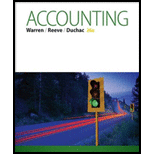
1.
Adjusting entries refers to the entries that are made at the end of an accounting period in accordance with revenue recognition principle, and expenses recognition principle. All adjusting entries affect at least one income statement account (revenue or expense), and one
Rules of Debit and Credit:
Following rules are followed for debiting and crediting different accounts while they occur in business transactions:
- Debit, all increase in assets, expenses and dividends, all decrease in liabilities, revenues and
stockholders’ equities . - Credit, all increase in liabilities, revenues, and stockholders’ equities, all decrease in assets, expenses.
Accrual basis of accounting:
Accrual basis of accounting refers to recognizing the financial transactions during the period in which the event occurs, even if the cash is not exchanged.
Income statement:
This is the financial statement of a company which shows all the revenues earned and expenses incurred by the company over a period of time.
Balance sheet:
This is the financial statement of a company which shows the grouping of similar assets and liabilities under subheadings.
To prepare: The adjusting entries in the books of Company AC at the end of the year.
2.
The effects on the income statement, if adjusting entries are not recorded.
3.
The effects on the balance sheet, if adjusting entries are not recorded.
4.
The effects on the “net increase or decrease in cash” on the statement of
Want to see the full answer?
Check out a sample textbook solution
Chapter 3 Solutions
Accounting (Text Only)
- Principles of Accounting Volume 1AccountingISBN:9781947172685Author:OpenStaxPublisher:OpenStax College
 College Accounting, Chapters 1-27AccountingISBN:9781337794756Author:HEINTZ, James A.Publisher:Cengage Learning,
College Accounting, Chapters 1-27AccountingISBN:9781337794756Author:HEINTZ, James A.Publisher:Cengage Learning, Cornerstones of Financial AccountingAccountingISBN:9781337690881Author:Jay Rich, Jeff JonesPublisher:Cengage Learning
Cornerstones of Financial AccountingAccountingISBN:9781337690881Author:Jay Rich, Jeff JonesPublisher:Cengage Learning - Century 21 Accounting Multicolumn JournalAccountingISBN:9781337679503Author:GilbertsonPublisher:Cengage
 Intermediate Accounting: Reporting And AnalysisAccountingISBN:9781337788281Author:James M. Wahlen, Jefferson P. Jones, Donald PagachPublisher:Cengage Learning
Intermediate Accounting: Reporting And AnalysisAccountingISBN:9781337788281Author:James M. Wahlen, Jefferson P. Jones, Donald PagachPublisher:Cengage Learning





